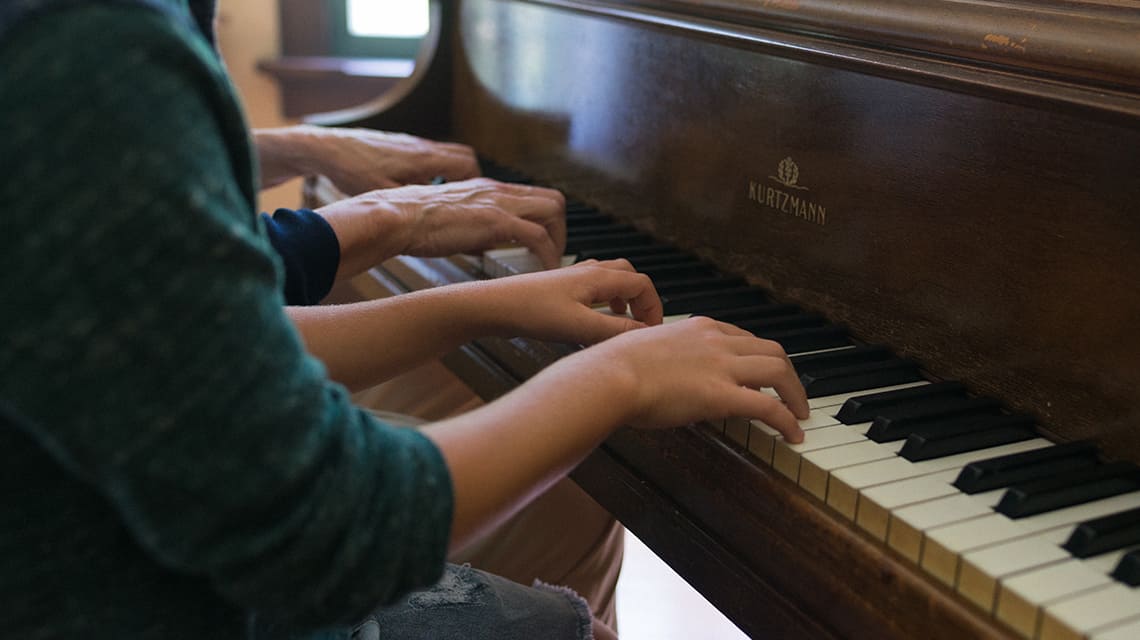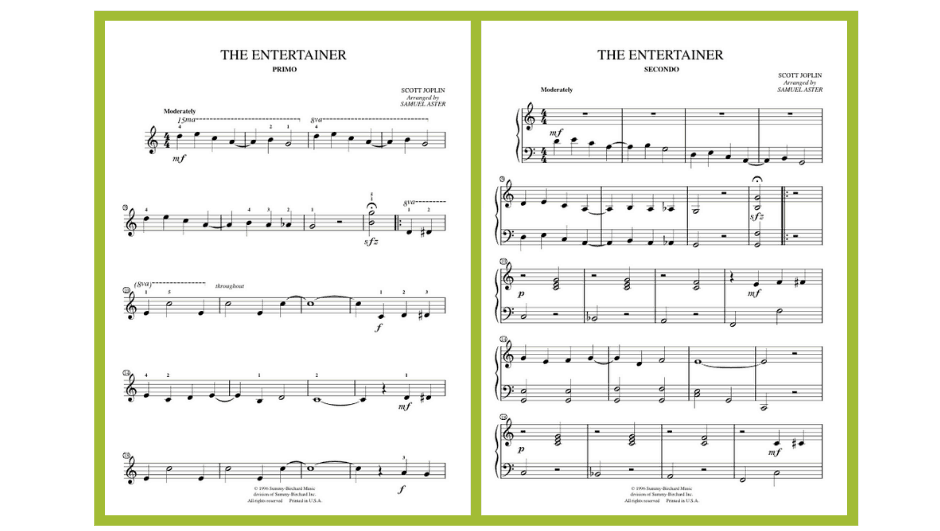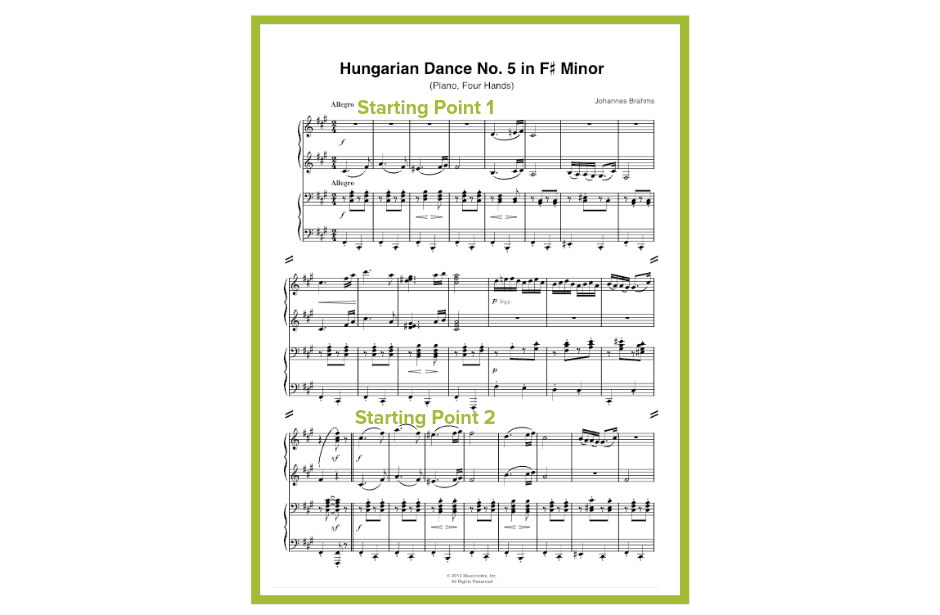11 Tips for Playing Piano Duets

Playing piano duets is so much fun! It’s exciting to put two different parts of music together to make one cohesive piece. Duets create a rich and fulfilling sound on the piano because you can maximize the full range of the piano. Plus, it’s a wonderful experience to collaborate with another musician, learn from them, and work together for a common goal.
There is a bit of a learning curve when it comes to playing piano duets. It can be frustrating to keep both parts together. Sharing the bench with another person and hearing a completely different part of music can be really disorienting. But, just like with your solo practice, playing duets will become easier and easier if you consistently put in the time and stay mindful of the best ways to approach this skill. These tips will help you make the most of your piano duet practice.
1. Find the Right Level of Duet
There are a lot of differences between playing a duet and play solo piano music. Since duet playing requires different skills than solo playing, consider leveling down with duet music. You don’t want your duet music to be so challenging that you can’t keep up or that it will take you too long to learn independently.
Start with a duet that is just a bit easier than what you would normally find challenging in a solo. If you and your duet partner play at different levels, find music that will accommodate the less experienced player.

An example of a simple piano duet. Click here to get the sheet music.
2. Learn Your Part First
Before you sit down with your duet partner, take plenty of time to learn your own part. You’ll want to be really confident with your part before you try to put the two parts together. In addition, your duet partner will appreciate not having to watch you work through fingering and learn your notes. And, you’ll get more from your duet practice time if you come prepared and confident with your part.
3. Count
It’s always important to count and feel the beat of the music while you practice, but it’s especially important to make this a priority when you are learning duet music. If one of the duet players isn’t counting, it will be impossible to make the music sync up. Use a metronome or play along with a very rhythmic recording of your piece to help you get in the habit of playing with excellent rhythm.
4. Slow Practice
There are a lot of details to hone in on while learning a duet. Slow practice is essential both for practicing your own part and for practicing together. If you can’t play correctly in a slower tempo, playing up to speed will be messy and inaccurate.
5. Listen to Each Other
Once you’re ready to put the two parts together, listening to each other will become essential. You have to tune in to your duet partner so that your music can become one.
It’s tempting to want to ignore the other part so that you can focus on playing your part well, but this approach is not effective. Even though you have been practicing rhythmically, the music will come alive when it can breathe. The two parts must flow together and this can only happen if you tune in equally to both parts.
6. Work Together to Plan Out Ways to Stay Together
Aside from listening closely to each other, there are many ways that duet partners can ensure that their music stays cohesive. Here are three simple ways to communicate with each other while playing a duet:
- Gesture. You can make small gestures with your hands that are similar to the way a conductor directs music. For example, subtle lifts of the hands will show your duet partner when you are about to approach the keys. This is useful as you start your piece, during tempo changes, or after long pauses.
- Nod. Similarly, nodding your head is another good way to indicate to the other player when you are about to begin or play a strong downbeat.
- Breathe. Using your breath is also a very effective way to help you sync up with your partner.
7. Don’t Stop
When practicing a solo, it is natural to start and stop to make corrections and perfect parts of the music as you go. But, duet practice requires maintaining continuity so that your music will gain momentum and stay together. Agree with your duet partner that you won’t stop playing no matter what. In time, it will train both of you to adapt and work through mistakes as they happen, rather than stopping to fix everything.
8. Make a Plan for How to Get Back on Track
It’s possible that things could fall apart while you’re playing a duet. Knowing that this could happen, you and your partner should make a plan for how you will recover. Designate one player as the leader who will make a call for how to proceed.
You’ll want to have several clear starting points throughout the piece that are easy to circle back around to in case things get out of control. The leader can direct the other player about where to go and how to start again for a fresh start.

9. Tune in to the Details Together
Playing duets is all about making music with another person. With a lot of focus on staying together and playing rhythmically, it is easy to lose sight of the creative, musical side of the piece. Take time to discuss how you plan to balance the dynamics and observe all of the musical markings found in the piece.
10. Practice Consistently
Just like you would practice a solo consistently over a period of time, plan to practice with your duet partner on a regular basis. One or two practice sessions usually isn’t enough time to learn all of the details of the music as well as how to work with your duet partner.
Just like any other collaborative effort, bringing two people together at the piano means mixing personalities, learning styles, different perspectives, and unique experiences. It can take time to learn how to practice efficiently and maximize both of your strengths as you work together.
11. Have Fun
Most importantly, playing duets on the piano is a really fun experience. Pianists spend plenty of time practicing at our instruments alone. Having an opportunity to explore music with another pianist is a special experience.
Enjoy your time creating music with another musician. Roll with the punches, bring your sense of humor, and be open to learning from one another.


